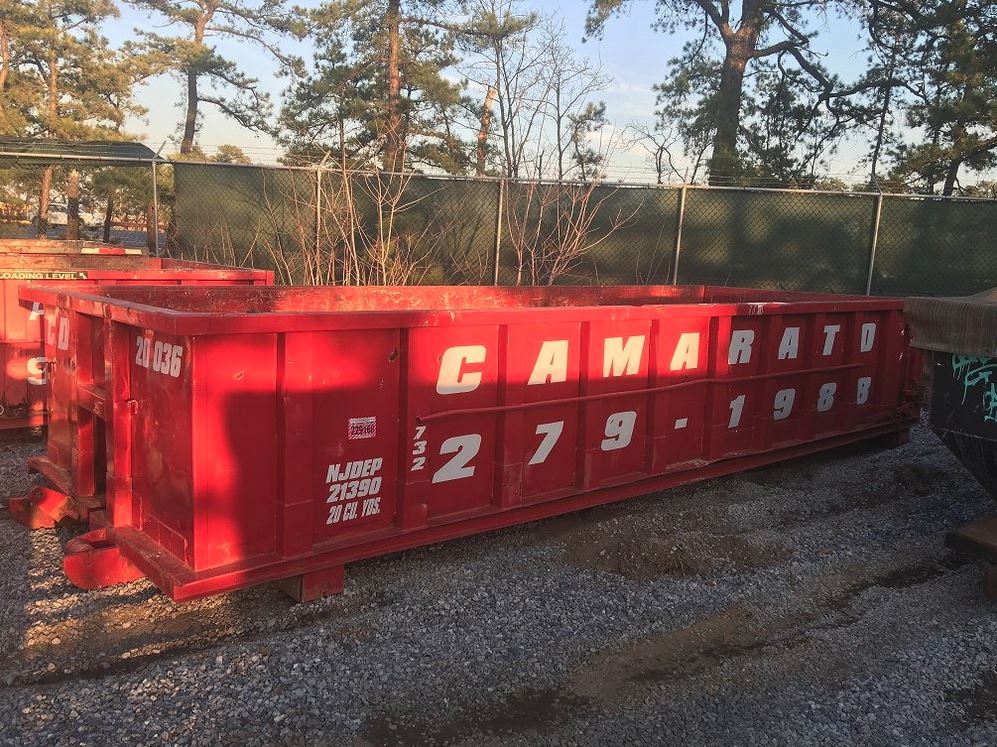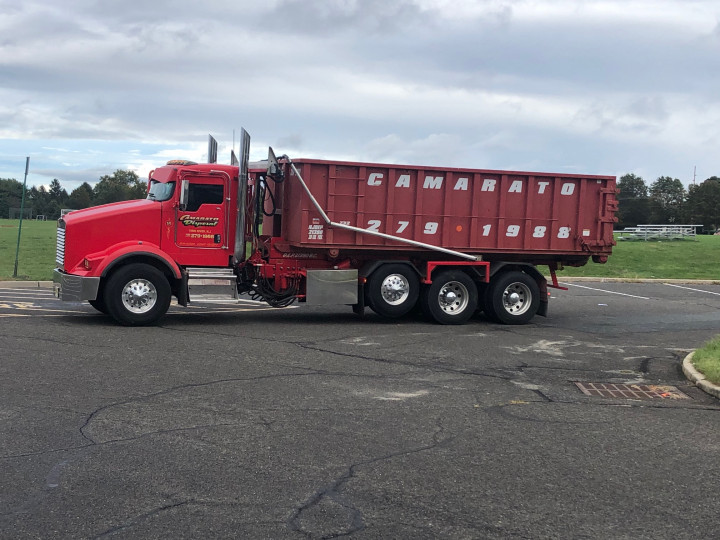
Maximizing the space in your New Jersey dumpster rental is not only a matter of packing smart; it’s about getting the most value for your investment. Whether you’re starting a home renovation project, cleaning out your garage, or managing construction debris, choosing the right size and type of dumpster is important.
At Camarato Disposal in Toms River, New Jersey, options range from 10 yard to 40 yard containers. Understanding how to fill them efficiently can save you time, money, and hassle. Here are some strategic tips for stacking, breaking down, and arranging your waste – especially bulky items and cardboard boxes – to ensure you make the most out of your dumpster rentals.
Understanding Dumpster Sizes and Types
When it comes to waste management for your construction project, home cleanout, or renovation, one of the first steps is selecting the right dumpster. Not all dumpsters are created equal, and choosing the appropriate size and type is crucial to maximize space and efficiently dispose of your waste, including bulky items and non-hazardous materials. Let’s break down the basics of dumpster sizes and types to help you make an informed decision.
Dumpster Sizes and Their Typical Uses
- 10 Yard Dumpster: This is the smallest size and is perfect for minor home cleanouts, small renovation projects, or clearing out a single room. Despite its compact size, it can handle a decent amount of debris, including small furniture and waste from yard work.
- 15 and 20 Yard Dumpsters: Step up in size, these dumpsters are suited for medium-scale renovations, roofing projects, or garage cleanouts. They are capable of accommodating a mix of light and heavy debris, making it a versatile option for many homeowners and contractors.
- 30 Yard Dumpster: Ideal for larger construction projects, major home additions, or extensive cleanouts, the 30-yard dumpster offers ample space for disposing of a wide range of materials. Its larger volume is particularly beneficial for managing bulkier items without quickly running out of room.
- 40 Yard Dumpster: The largest standard size available, a 40-yard dumpster, is tailored for major construction and demolition projects, commercial cleanouts, and large-scale waste removal tasks. It’s designed to handle the heftiest loads, including bulky items and substantial amounts of construction debris.
Dumpster Types: Focusing on Roll-Off Dumpsters
Among the various dumpster types, roll-off dumpsters are especially noteworthy for their convenience and versatility. Characterized by their rectangular shape and ability to be “rolled off” a special truck onto your property, these dumpsters are accessible and easy to load. The open-top design makes them an excellent choice for projects that involve disposing of large, bulky items or significant volumes of waste. Their sturdy construction also means they can handle heavier materials found in construction sites, such as concrete, metal, or wood, without damage.
Preparing Items for the Dumpster
Before you start tossing items into your dumpster, taking a moment to properly prepare them can save you space and hassle. Whether you’re dealing with old furniture, a pile of cardboard boxes, or a mix of materials from your latest project, how you handle these items before disposal can make a significant difference in maximizing your dumpster space. Here are some tips on breaking down items and sorting materials effectively.
Dismantling Furniture
Furniture can be one of the most space-consuming items in a dumpster. Before disposal, take the time to dismantle it. Remove legs from tables and couches, take apart bed frames, and disassemble any pieces that can be broken down. This doesn’t just create more space; it also makes the items easier to manage and dispose of.
When dismantling furniture, always use proper lifting techniques to avoid injury. Bend at the knees and keep your back straight when picking up heavy items. If possible, work with another person to share the load, especially for bulky or awkwardly shaped pieces.

Flattening Cardboard Boxes
Cardboard boxes are voluminous but easily compressed. Flattening these boxes is a simple yet effective way to maximize interior space within your dumpster. Break down boxes by collapsing them along their seams. No need to remove any non-cardboard components such as plastic liners or tape.
Sorting Materials
Sorting your materials before disposal is not just about organization; it’s about environmental responsibility and efficiency. Identify materials that can be recycled and those that require special disposal methods. Metals, plastics, and paper can often be recycled, reducing the amount of waste sent to landfills and conserving dumpster space for non-recyclable items.
For hazardous materials or items that require special disposal methods (like electronics, batteries, or certain types of light bulbs), set them aside and contact your local waste management facility for guidance on proper disposal. Disposing of these items in a standard dumpster is not only unsafe but may also violate local regulations.
The Benefits of Preparation
By taking the time to prepare your items for the dumpster, you not only make the most out of the available space but also contribute to a more efficient and environmentally friendly waste management process. Dismantling furniture and flattening cardboard boxes are straightforward steps that can significantly increase the interior space of your dumpster, allowing you to fit more debris and reduce the need for multiple hauls.
Prohibited Items and Hazardous Waste
When filling your rented dumpster, especially if it’s a roll-off dumpster that can accommodate a significant amount of waste, it’s crucial to be aware of what can and cannot be disposed of in it. While dumpsters are incredibly versatile, designed to hold everything from construction debris to household junk, there are specific items that are prohibited due to local regulations or the policies of the dumpster rental company. Understanding these restrictions is essential not only for legal compliance but also for environmental protection.
Common Prohibited Items
Typically, the list of items you cannot throw into a rented dumpster includes, but is not limited to:
- Hazardous Waste: This includes items like paints, solvents, chemicals, and batteries.
- Electronics: Televisions, computers, monitors, and other electronic devices are often banned due to their toxic components.
- Appliances: Refrigerators, air conditioners, and anything containing Freon or similar substances.
- Tires: Due to recycling rules and potential damage to landfill structures, tires are usually not allowed.
- Flammable Liquids: Gasoline, motor oil, and other flammable materials are prohibited for safety reasons.
These items are banned because they contain hazardous materials that can leach into the ground, causing environmental damage, or pose significant health and safety risks during the disposal process.
Proper Disposal of Hazardous Waste
Disposing of hazardous waste requires careful consideration and adherence to local regulations. Here’s how you can handle these materials responsibly:
- Contact Local Waste Management Authorities: Your city or county waste management department can provide guidance on where and how to dispose of hazardous waste. Many areas have designated drop-off sites for such materials.
- Participate in Collection Events: Look out for community hazardous waste collection events, which are often free and provide a safe way to rid yourself of dangerous items.
- Follow Specific Disposal Guidelines: Certain items may have specific disposal instructions, such as taking electronics to a recycling center or returning used motor oil to an auto shop. Always follow these guidelines to ensure safe and legal disposal.
Why It Matters
Being mindful of what goes into your rented dumpster does more than just save room for allowable waste; it ensures that you’re not contributing to environmental pollution or risking fines and penalties for improper disposal. By keeping prohibited items out of your dumpster, you’re making a responsible choice that benefits both your community and the planet.
Maximizing Your Dumpster Rental Experience
Understanding how to effectively prepare items for disposal, knowing what materials are prohibited, and being aware of the hazardous waste disposal guidelines are crucial aspects of maximizing the efficiency of your dumpster rental. By dismantling furniture, flattening cardboard boxes, and sorting materials, you not only create more room in your dumpster but also ensure that you are utilizing the dumpster size to its fullest potential.
Choosing the right dumpster size for your project and adhering to these practices can significantly minimize environmental impact, provide cost savings by possibly reducing the need for multiple hauls, and ensure compliance with local regulations. Remember, the key to a successful disposal or cleanup project lies not just in the size of the dumpster you rent but also in how effectively you can fill it. By being mindful of what and how you dispose of waste, you contribute to a more sustainable and efficient waste management process.
